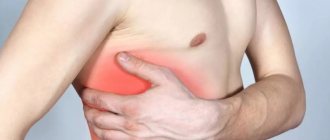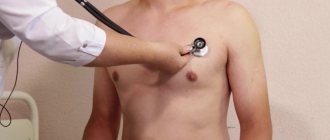The appearance of pain indicates disturbances in the functioning of the body. We are talking about pathologies. The most common problem is discomfort in the heart area. They can be pulling, cutting, blunt or sharp. They have different intensity and duration. In some cases, the pain radiates to the arm or head. Then the problems are associated with neighboring organs of the human body.
What causes pain in the area of the heart and left shoulder blade? How to get rid of poor health, and which specialist should I contact? At the KDS Clinic, medical workers will conduct examinations, diagnose the disease even at an early stage and prescribe effective treatment.
In addition to pain in the heart area and under the shoulder blade, the patient experiences a number of other symptoms. These include dizziness, chronic fatigue, nausea and vomiting, migraines, and gastrointestinal disorders. It is extremely important to contact a medical facility on time. Ignoring pain leads to the development of the disease and deterioration of the condition. The treatment started will normalize the functionality of the body and prevent the development of the disease.
How does a pinched nerve manifest?
Intense, stabbing or shooting (like an electric shock) pain in the neck, lower back or chest. The pain can spread to the arm, to the back of the head, along the rib into the chest, often to the heart area, or to the leg. In the compression zone, the muscles are tense, spasmed, and there may be swelling of the soft tissues. Muscle tension leads to curvature of the spine; on the side of pain, the shoulder, shoulder blade, and thigh rise. This “distortion” of the back muscles is called a painful (algic) pose. If proper treatment is not given, a pinched nerve can persist for several weeks and significantly impair the patient's quality of life.
Causes of pinched nerve:
- The most common cause is osteochondrosis. In this case, the roots of the spinal nerves are pinched in the intervertebral foramina at the site of protrusion (bulging) of the intervertebral disc. An additional cause of pinched nerves is bone growths of the vertebrae (osteophytes).
- A herniated disc is a complication of osteochondrosis and, as a rule, leads to persistent pinching of the nerve root. In this case, the pain spreads along the arm or leg and is accompanied by decreased reflexes, impaired skin sensitivity, a feeling of “tingling needles” or weakness in the fingers or toes.
- Constant intense physical activity leads to compression of the nerve between the muscles and tendons. These are the so-called “tunnel” syndromes. They occur in people of certain professions: athletes, tennis players (pinched nerve in the elbow), typists and other “typing” people (compression in the wrist).
What to do and how to stop an attack
With shortness of breath or dyspnea, breathing is disrupted, becomes more frequent, with difficulty inhaling or exhaling, and a lack of air is often felt. There are many reasons that affect both the respiratory system and the functioning of the cardiovascular system. Do not worry if shortness of breath appears after increased exercise, physical fatigue, stress or emotional distress - this is a normal manifestation of the physiological reaction of the body of a healthy person to the body’s increased need for oxygen.
A more alarming symptom is a pain attack, cardialgia. Measures for heart pain and heavy breathing:
- Take a comfortable position, sit down and lie down.
- Don’t panic, try not to think about the bad.
- Restore your breathing by taking calm, measured inhalations and exhalations.
- If the room is stuffy, open the window and free your neck from tight clothing.
- For patients with hypertension, measure blood pressure. When the numbers increase above normal, they take antihypertensive drugs.
- If squeezing or stabbing pain in the heart bothers you for more than 10-15 minutes, call an ambulance.
- It is not recommended to take medications on your own before the ambulance arrives.
- Pregnant women who experience severe pain in the heart and difficulty breathing should immediately contact an obstetrician-gynecologist.
- Elderly patients with persistent deterioration of their condition, severe cardialgia and a feeling of lack of air should take a Nitroglycerin tablet under the tongue and call an ambulance.
- When episodes of heart pain and shortness of breath quickly pass with rest, but are repeated more and more often, go to the doctor for a routine examination.
What examinations are necessary for a pinched nerve?
An important diagnostic method is electromyography (EMG). It is this study that objectively assesses the degree of compression (damage) of the nerve. An EMG records the conduction of electrical impulses along the nerves of an arm or leg and gives the doctor an assessment of the state of the peripheral nervous system.
Magnetic resonance imaging (MRI) and computed tomography (CT) can assess the condition of the vertebrae and intervertebral discs, the presence of hernias and protrusions, and spinal cord damage.
X-ray of the spine
informative in case of poor posture - scoliosis, kyphosis, as well as injuries: fractures and subluxations of the vertebrae.
Diagnosis of the condition
The reason why the heart aches is determined by an experienced specialist already at the stage of examining and interviewing the patient. But an accurate diagnosis requires a complete examination. The fact is that I encountered atypical manifestations of angina and heart attack. And the most important thing with such a symptom is to exclude them or confirm them and begin timely treatment.
Laboratory research
To clarify the cause, if a person’s heart aches, it is necessary to take:
- General blood analysis. Taken from a finger, it allows you to determine indirect signs of the inflammatory process, anemia (with pathology of the stomach or intestines). It has no informative value for diagnosing ischemic heart disease or spinal problems. A decrease in iron levels can be considered a factor that worsens the condition when coronary blood flow is impaired.
- Biochemical research. It is carried out by collecting venous blood in the morning on an empty stomach. I often see high cholesterol levels in patients with coronary artery disease. But this sign rather confirms the cause of angina - blockage of the lumen with a fatty plaque. A very important criterion for the presence of a heart attack is an increase in the level of creatine phosphokinase, lactate dehydrogenase, troponins and myoglobin. An increase in ALT and AST is also observed in this pathology, but they can also appear in diseases of the liver and pancreas.
Instrumental
The main method for confirming or excluding pathology of the heart muscle is an ECG. But in some cases, it is not enough and there is a need to resort to other diagnostic methods:
- On the electrocardiogram, deviations in the form of an increase in the T wave, an increase in ST above the isoline become signs of myocardial ischemia. If such a phenomenon is observed only when the heart is pinched, and in the period between attacks everything returns to normal, then this indicates angina pectoris. In case of a heart attack, even after pain relief, negative dynamics are observed on the ECG and it continues until scar formation occurs. Large-focal necrosis is recorded by the appearance of a pathological Q wave, which may persist in the future after treatment and complete rehabilitation of the patient.
- Radiography. To examine the chest organs, images are taken in several projections. They can show darkening or clearing of the fields in the lungs, the presence of cavernous cavities or effusion in the pleura. As well as damage to the vertebrae and destruction of bone tissue.
- A CT scan is performed by taking a series of images, which are then processed by a computer. Provides very accurate data on changes in the spine and lungs and other organs of the chest. With its help, a reliable picture of all deviations from the norm is recreated.
- MRI is carried out on the same principle, only tissues are exposed to radiofrequency pulses, after which they emit an electromagnetic field in response, which is captured by devices and processed. In this case, it is possible to obtain high quality sections. It is carried out to diagnose spinal pathologies and helps detect changes in blood vessels (for example, aortic dissection).
- A very important method for clarifying the degree of narrowing and localization of the problem area in the heart vessel in case of coronary artery disease is coronary angiography. This is an invasive method because it requires internal intervention. A probe is inserted through a puncture in the vein and advanced to the myocardium under X-ray control. Then the person is injected with a contrast agent, and its progress is recorded. In this way, it is possible to identify all types of disturbances in the passage of blood through the arteries of the heart muscle.
Effective treatment for pinched nerves
Traditional treatments for pain symptoms include anti-inflammatory painkillers (NSAIDs), muscle relaxants (drugs that relax muscles), drugs that improve blood circulation, B vitamins, and physical therapy. These methods reduce symptoms, but do not affect the causes and mechanisms of the disease.
Blockades of pressure points and paravertebral blockades are a classic effective method of treating muscle-articular pain. The doctor specifically introduces a complex of pain medications (into the pain “trigger” zone or along the pinched nerve). Pain relief occurs a few minutes after the injection.
An alternative modern method for treating osteochondrosis, scoliosis and herniated intervertebral discs is shock wave therapy. The principle of UVT is the effect of low-frequency sound waves on tense muscles and ligaments, joints, and bones. The acoustic wave reduces inflammation of the pinched nerve, restores blood circulation and starts the process of cell regeneration. There are known cases of restoration of bone structure after the onset of bone necrosis.
The First Neurology clinic actively uses more than 20 types of treatment for pain syndromes in the back and limbs, as well as headaches. Modern high-tech methods relieve pain after 2-3 sessions and reduce the drug load (the amount and duration of taking pain medications).
These methods include, first of all, carboxytherapy. The introduction of small amounts of carbon dioxide into the projections of the spine and joints causes blood flow and stimulates blood circulation in the area of the pinched nerve. Carboxytherapy has a rapid analgesic effect, improves trophism (nutrition) of intervertebral discs and nerves. The undoubted advantage of the method is the absence of side effects.
Mesoinjection therapy has been used at the First Neurology clinic for more than 10 years. This is a method of introducing drugs into the deep layer of skin - mesoderm. Locally - in the projection of the pinched nerve, the neurologist administers muscle relaxants (muscle relaxers) or vascular, anti-inflammatory drugs. The absorption and effect of the drug last more than 2 weeks, so mesotherapy is performed once every 14 days.
Hi Top high-tone therapy is the method of choice in the treatment of a pinched nerve in an arm or leg. By applying pulsed current to the sensory endings of the peripheral nerve, Hi Top stimulates the nerves, muscles and spinal cord.
Dosed traction of the spine is carried out at the First Neurology clinic using the specialized orthorpedic complex ORMED-Professional. Traction eliminates pinched spinal nerves, reduces back muscle tone, and quickly relieves pain in the spine.
Pain in the heart area radiates to the shoulder blade. Diagnostics
If your heart hurts and radiates under your shoulder blade, then you should consult a specialist as soon as possible. At the KDS Clinic, patients undergo a comprehensive examination using modern equipment and new technologies. After the initial examination, the patient informs the doctor about the nature and frequency of pain. The patient is referred for tests and examinations. When your heart hurts and radiates to your shoulder blade, visit a cardiologist, neurologist and orthopedist. Undergo ultrasound diagnostics, electrocardiogram and Holter examination. Call the clinic at number.
Our specialists
Tarasova Svetlana Vitalievna
Expert No. 1 in the treatment of headaches and migraines. Head of the Center for the Treatment of Pain and Multiple Sclerosis.
Somnologist.
Epileptologist. Botulinum therapist. The doctor is a neurologist of the highest category. Physiotherapist. Doctor of Medical Sciences.
Experience: 23 years.Derevianko Leonid Sergeevich
Head of the Center for Diagnostics and Treatment of Sleep Disorders.
The doctor is a neurologist of the highest category. Vertebrologist. Somnologist. Epileptologist. Botulinum therapist. Physiotherapist. Experience: 23 years.
Palagin Maxim Anatolievich
The doctor is a neurologist. Somnologist. Epileptologist. Botulinum therapist. Physiotherapist. Experience: 6 years.
Romanova Tatyana Alexandrovna
Pediatric neurologist. Experience: 24 years.
Temina Lyudmila Borisovna
Pediatric neurologist of the highest category. Candidate of Medical Sciences.
Experience: 46 years.
Zhuravleva Nadezhda Vladimirovna
Head of the center for diagnosis and treatment of myasthenia gravis.
The doctor is a neurologist of the highest category. Physiotherapist. Experience: 16 years.
Mizonov Sergey Vladimirovich
The doctor is a neurologist. Chiropractor. Osteopath. Physiotherapist. Experience: 8 years.
Bezgina Elena Vladimirovna
The doctor is a neurologist of the highest category. Botulinum therapist. Physiotherapist. Experience: 24 years.
Drozdova Lyubov Vladimirovna
The doctor is a neurologist. Vertebroneurologist. Ozone therapist. Physiotherapist. Experience: 17 years.
Read also
Senestopathies
Senestopathies are various painful sensations that are almost always difficult to describe by patients, originating from various areas of the body, internal organs, and which cannot be explained...
Read more
Epicondylitis
Do you know this disgusting feeling when you are passionately doing something, and suddenly, quite by accident, your elbow bumps into something hard and in that very place, after the impact of which the whole arm weakens...
More details
Aphasia
Aphasias are speech defects that appear with minor brain damage, most often affecting the left hemisphere in right-handed people, and consisting of various forms of speech changes. Location and size...
More details
Polyneuropathy
Diabetic polyneuropathy is a pressing problem for patients with diabetes. Diabetic polyneuropathy is a serious complication of diabetes mellitus. The incidence of polyneuropathy is 26-50%...
More details
Myasthenia gravis
MYASTHENIAS – a disease associated with a disruption of the immune system, as a result of which antibodies are produced against the body’s own tissues involved in the transmission of nerve impulses, which...
More details








